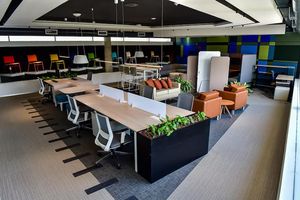Modern office furniture refers to modern design and functionality of desks, chairs, storage units, meeting tables and collaboration sets used in today's workplaces. These designs focus on flexibility, ergonomics, aesthetics and technology integration. Unlike traditional furniture, which often emphasizes formalities and durability, modern furniture supports dynamic work styles, mobile workforce and hybrid work models.
This development exists on a large scale of how the work is done, due to the change. The emergence of digital technology, distance cooperation equipment and changed employees' expectations has changed the office layout. Designed today's furniture, it is designed to support both productivity and welfare, and helps employees stay comfortable, focused and connected to whether they are full -time in the office or a few days in a week.

Why modern office furniture matters in today’s workplace
Modern office furniture plays an important role in how companies support their teams. The theme affects a wide range of stakeholders:
-
Employees, who are looking for ergonomic and flexible setups to stay healthy and productive.
-
Employers, who aim to increase office contact and support hybrids or external models.
-
Construction managers, who need scalable, space savings and durable solutions.
It addresses several key workplace challenges:
-
Ergonomic problems: Poor attitude and long -term sitting can cause health problems. The purpose of modern furniture is to reduce these risks.
-
Room efficiency: Modular and multi -use furniture helps to adapt limited office space.
-
Flexibility for hybrid work: Furniture that supports hot tires, mobile workstation and team-based configuration is quickly essential.
-
Stability goals: Companies invest quickly in environmentally responsible furniture.
For companies, it contributes to investing in modern office furniture for employee satisfaction, brand image and long -term cost efficiency.
Recent trends and updates in office furniture
Over the past year, several notable trends and changes have emerged in office furniture design and purchasing:
Flexible and hybrid furniture
-
Mobile workstations and modular desks have become popular due to hybrid work environment.
-
Manufacturers use qualified pieces that allow for rapid layout changes, and support both individual and group functions.
Ergonomics-focused design
-
Several companies buy SIT-stand desktop, adjustable screensholds and supportive chair to promote health.
-
According to industry reports, the use of height -willing furniture in 2024 increased by about 18%.
Sustainable materials and certifications
-
There is a growing demand for environmentally friendly materials such as bamboo, recycled plastic and FSC-determined wood.
-
To identify low power and durable products, labels such as BIFMA Level® certification or Greenenguard are used quickly.
Tech integration
-
Furniture built in wireless charging, USB-C port and smart lighting are more common.
-
Acoustic bellows and privacy stalls, designed with sound insulation and underlying ventilation, support virtual meetings and concentrated work.
Biophilic design elements
-
Furniture increases with natural texture, indoor plant support and biological figures.
-
This is in line with a wider workplace trend to involve nature in the atmosphere in the office to improve welfare.
Workplace Health and Safety Regulations
In most countries, including the U.S., UK, Australia, and EU member states, employers are legally required to provide safe and ergonomic working conditions. This includes:
-
Using chairs that support the back and reduce musculoskeletal disorders.
-
Providing adjustable desks or monitor stands.
Environmental regulations
-
In relation to chemical safety, furniture may have to follow rules such as Reach (EU) or TSCA (USA).
-
Public contracts can favor suppliers that offer low-furor or continuous citrus products.
Tools and resources to help plan or choose office furniture
Whether you are the owner, office manager or designer of a business, many tools can help you choose or organize modern office furniture:
-
Create a 3D model to imagine the space planner - setup and vacancy of SketchUp.
-
A user-friendly app to design the planner's 5D office sites.
-
Ergocalculator (from the University of Cornell) - helps evaluate the ergonomics of the desktop layout.
-
BIFMA website (www.bifma.org) - provides guidance on certified permanent furniture.
-
Office Snapshot-Company - a website that shows inspiration in the real life office of Company or furniture type.
-
Government Argonomics Guide - many national security agencies for workplaces publish free guidelines.
The use of these units can help increase the budget, compliance and workpiece's efficiency.
Frequently Asked Questions (FAQs)
What makes office furniture "modern"?
Modern office furniture usually has clean lines, minimal designs, ergonomic functions and adaptability for hybrid work environment. It also includes technical integration and durable material.
How often should office furniture be updated?
There is no clear rule, but ergonomic seating may require replacement every 5-7. Year. The desks and tables may last a long time, but new task may require updates to match styles or design needs.
Is there a legal requirement for ergonomic furniture?
In many countries, employers must ensure work health and comfort. This involves providing ergonomic furniture to reduce stress or damage, especially for a desk -based roles.
Can modern office furniture improve productivity?
Yes, research suggests that ergonomically designed and well -organized furniture can reduce physical discomfort and support better focus, collaboration and employees' satisfaction.
What should I consider when buying furniture for a hybrid office?
For flexibility, modularity, space -saving design and technically friendly features. Mobile desks, acoustic bellows and multi -use storage units are particularly useful in the hybrid environment.
Conclusion
Modern office furniture is more than a design alternative - this is a reflection of how the business is changing, taking care of their teams and productive tasks creates the environment. Being informed of current trends and available equipment is ensured that your office is functional, inclusive and ready for the future.